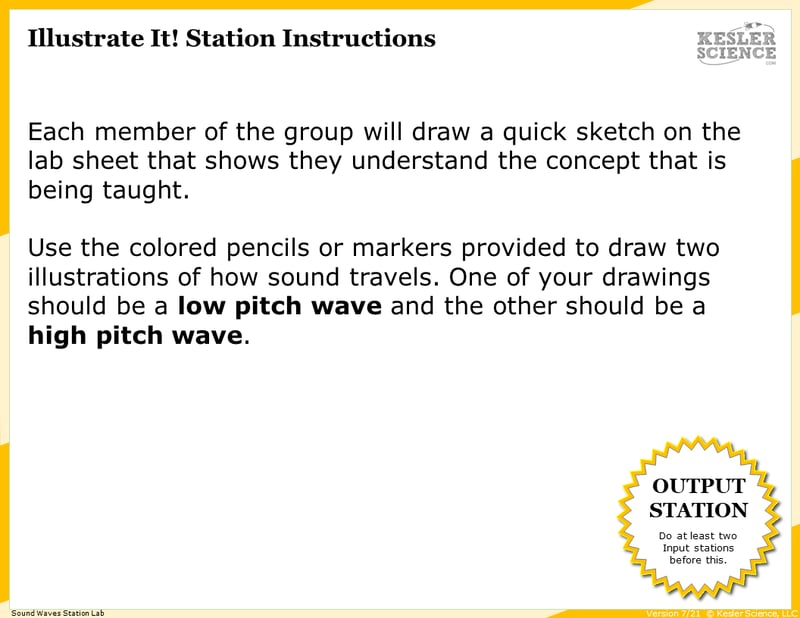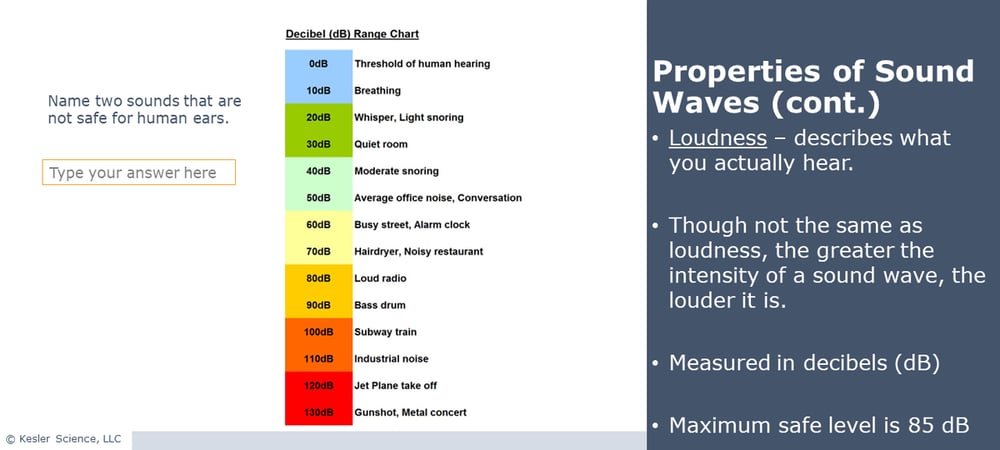Sound Waves Lesson Plan - A Complete Science Lesson Using the 5E Method of Instruction
By the end of this lesson about sound waves, students will be able to define the word sound, explain how sound waves travel, describe the physical properties of a medium and explain its effect on the waves’ speed, compare the properties of waves that affect what we hear, and demonstrate the Doppler effect. Each of our lessons is designed using the 5E method of instruction to ensure maximum comprehension by the students. This well-thought out unit does the heavy lifting, giving teachers easy-to-implement, highly engaging lesson plans.
This blog will walk you through each of the steps and activities from the Sound Waves 5E Lesson Plan.
ENGAGEMENT
Objective Introduction
At the beginning of the lesson, the class will do a Think-Pair-Share to discuss the objective.
Class Activity
- Tell the students that they'll be studying sound waves.
- Ask students to watch the video using the provided link.
- Have them make a list of vocabulary words they want to know the meaning of.
Student Activity
- Divide the class into groups of three or four students.
- Give each group materials that will make sounds.
- Have students try to make as many sound as they can with the objects they've been provided.
- After they have made sounds with the objects, ask them to try to make the sound louder.
- Have a class discussion about how they made the sounds and how they made them louder.
- Discuss any vocabulary words they listed and explain that you will be teaching more about these words in the following lesson.

Afterwards, the teacher will help to clear any misconceptions their students have about sound waves. A common but major misconception, for example, is that students may not realize that sound is created by vibrations disturbing the particles in different mediums.
Estimated Class Time for the Engagement: 20-30 minutes
EXPLORATION
This student-centered station lab is set up so students can begin to explore sound waves. With nine stations in total, you can introduce them to your middle school students in a variety of ways! Four of these stations are considered input stations where students will learn new information about sound waves, and four of the stations are output stations where students will be demonstrating their mastery of the lesson's material. A bonus station offers challenges for your early finishers and independent learners. You can read more about how I set up the station labs here.
Watch It!
At this station, students will be watching a short video explaining sound waves. Students will then answer questions related to the video and record their answers on their lab station sheet. For example: How does your voice produce sounds? What types of waves are sound waves? What are the three different mediums that sound can travel through? Which is the slowest and which is the fastest?
Read It!
This station will provide students with a one-page reading about sound waves. There are four follow-up questions for students will answer to demonstrate their comprehension of the reading material.
Explore It!
Students will be working in pairs to better understand sound waves. At this station, students interact with a couple of cans and some string. Students will follow the steps and record their observations on their lab sheet.
Research It!
The research station will allow students to explore an interactive web page that helps them to understand sound waves. Students will be instructed to complete a few tasks and record answers on their lab sheets.
Organize It!
Students at this station will be provided with a set of cards for them to match. On these cards are objects, descriptions, and sound waves for students to figure out how to match together. Once students have completed their organization, the teacher will check their understanding.
Illustrate It!
Your visual students will love this station. Students are to draw pictures that demonstrate their knowledge of sound waves (low pitch waves and high pitch waves).

Write It!
Students who can answer open-ended questions about the lab truly understand the concepts that are being taught to them. At this station, the students will be answering three task cards: Explain how sound travels. What is the difference between a high pitch sound and a low pitch sound? Provide examples. Why can sound not travel in space?
Assess It!
The Assess It station is where students will go to prove mastery over the concepts they learned in the lab. The questions are set up in a standardized format with multiple choice answers. Some questions include: Which is not true about longitudinal waves? Which object made the sound wave labeled “B”? Sound can travel through everything but a _____.
Challenge It! - Bonus Station
Early finishers and advanced students will love the extension activities in this station. Four activity choices offer them ways to expand their learning through mini-games and mini-projects.
Estimated Class Time for the Exploration: One or two 45-minute class periods
EXPLANATION
The explanation activities will become much more engaging for your class once they’ve completed the exploration station lab. During the explanation piece of the lesson, the teacher will be clearing up any misconceptions their students may have about sound waves with a variety of materials. These materials include on-level and modified versions of the interactive presentation (may be used individually or projected), anchor charts, and paper or digital interactive notebook activities.


Interactive notebook samples: Above-left is a digital INB activity slide; above-right is an example of the paper INB activities.
The students will also be interacting with their journals while taking notes from the PowerPoint. If you have students that need modified notes, the 5E lessons come equipped to help give every student access to the lesson.
Estimated Class Time for the Exploration: Two or three 45-minute class periods
ELABORATION
The elaboration section of the 5E method of instruction gives students choices that allow them to prove they’ve mastered the concepts behind the lesson. When students are given a choice, they’re much more enthusiastic and invested in the project than they are when their teachers choose their projects for them. There are a total of nine choices to demonstrate understanding of sound waves. A separate set of choices that offer more teacher support are also available for students that need them. Rubrics guide students to doing their best work and assist in grading.

Estimated Class Time for the Elaboration: Two or three 45-minute class periods (can also be used as an at-home project)
EVALUATION
The final piece of the 5E model is to evaluate your students' comprehension. Included in every 5E lesson is a homework assignment, assessment, and modified assessment. Research has shown that homework needs to be meaningful and applicable to real-world activities in order to be effective. When possible, I like to give open-ended assessments to truly gauge the student’s comprehension.
Estimated Class Time for the Elaboration: One 45-minute class period
DOWNLOAD THE FULL LESSON NOW
Download Over $100 in FREE Resources
For Middle School Science
Simply create a login below and gain immediate access to a selection of our Kesler Science product line worth $100 - for FREE. There's a full version of every product type! You'll also join tens of thousands of middle school science teachers who receive timely tips and strategies straight to their inbox.







